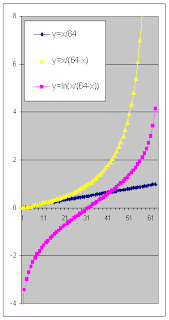Estimation iterations

In my last few blogs I have used Java to generate a dataset simulating 64 students sitting a 64 item test. I have talked about the "prox" method of estimation discussed in the Winsteps documentation. I shall now show the results of seven iterations through the dataset using this formula: d i ' = m i - root(1 + s i 2 /2.9)d i where d i ' is the revised item difficulty and d i is the previous estimate of item difficulty, m i is the mean ability of the children from the most recent estimate and s i is the standard deviation of those abilities. The chart immediately below shows the raw mean item difficulty as di0 and the mean item difficulty from 6 subsequent iterations. The chart below that shows the variance of raw item difficulty as di0 and the variance from 6 subsequent iterations. It is clear from these charts that the best estimate of difficulty and the tightest distribution is the original dataset. Four addition iterations were carried out but not char...

